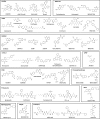Using in Vitro Evolution and Whole Genome Analysis To Discover Next Generation Targets for Antimalarial Drug Discovery
- PMID: 29451780
- PMCID: PMC5848146
- DOI: 10.1021/acsinfecdis.7b00276
Using in Vitro Evolution and Whole Genome Analysis To Discover Next Generation Targets for Antimalarial Drug Discovery
Abstract
Although many new anti-infectives have been discovered and developed solely using phenotypic cellular screening and assay optimization, most researchers recognize that structure-guided drug design is more practical and less costly. In addition, a greater chemical space can be interrogated with structure-guided drug design. The practicality of structure-guided drug design has launched a search for the targets of compounds discovered in phenotypic screens. One method that has been used extensively in malaria parasites for target discovery and chemical validation is in vitro evolution and whole genome analysis (IVIEWGA). Here, small molecules from phenotypic screens with demonstrated antiparasitic activity are used in genome-based target discovery methods. In this Review, we discuss the newest, most promising druggable targets discovered or further validated by evolution-based methods, as well as some exceptions.
Keywords: malaria; phenotypic screening; resistance; selections.
Conflict of interest statement
The authors declare no competing financial interest.
Figures



Similar articles
-
Open-source discovery of chemical leads for next-generation chemoprotective antimalarials.Science. 2018 Dec 7;362(6419):eaat9446. doi: 10.1126/science.aat9446. Science. 2018. PMID: 30523084 Free PMC article.
-
Efforts Aimed To Reduce Attrition in Antimalarial Drug Discovery: A Systematic Evaluation of the Current Antimalarial Targets Portfolio.ACS Infect Dis. 2018 Apr 13;4(4):568-576. doi: 10.1021/acsinfecdis.7b00211. Epub 2018 Jan 24. ACS Infect Dis. 2018. PMID: 29320160
-
The antimalarial resistome - finding new drug targets and their modes of action.Curr Opin Microbiol. 2020 Oct;57:49-55. doi: 10.1016/j.mib.2020.06.004. Epub 2020 Jul 15. Curr Opin Microbiol. 2020. PMID: 32682267 Free PMC article. Review.
-
New horizons in antimalarial drug discovery in the last decade by chemoinformatic approaches.Comb Chem High Throughput Screen. 2015;18(2):129-50. doi: 10.2174/1386207318666141229125155. Comb Chem High Throughput Screen. 2015. PMID: 25543682 Review.
-
Phenotypic Screening of Small Molecules with Antimalarial Activity for Three Different Parasitic Life Stages.Methods Mol Biol. 2018;1787:41-52. doi: 10.1007/978-1-4939-7847-2_3. Methods Mol Biol. 2018. PMID: 29736708
Cited by
-
Open-source discovery of chemical leads for next-generation chemoprotective antimalarials.Science. 2018 Dec 7;362(6419):eaat9446. doi: 10.1126/science.aat9446. Science. 2018. PMID: 30523084 Free PMC article.
-
Challenges and Tools for In Vitro Leishmania Exploratory Screening in the Drug Development Process: An Updated Review.Pathogens. 2021 Dec 10;10(12):1608. doi: 10.3390/pathogens10121608. Pathogens. 2021. PMID: 34959563 Free PMC article. Review.
-
Reaction hijacking inhibition of Plasmodium falciparum asparagine tRNA synthetase.Nat Commun. 2024 Jan 31;15(1):937. doi: 10.1038/s41467-024-45224-z. Nat Commun. 2024. PMID: 38297033 Free PMC article.
-
In vitro evolution and whole genome analysis to study chemotherapy drug resistance in haploid human cells.Sci Rep. 2024 Jun 18;14(1):13989. doi: 10.1038/s41598-024-63943-7. Sci Rep. 2024. PMID: 38886371 Free PMC article.
-
The past, present and future of anti-malarial medicines.Malar J. 2019 Mar 22;18(1):93. doi: 10.1186/s12936-019-2724-z. Malar J. 2019. PMID: 30902052 Free PMC article. Review.
References
Publication types
MeSH terms
Substances
Grants and funding
LinkOut - more resources
Full Text Sources
Other Literature Sources

